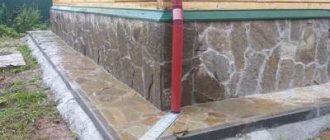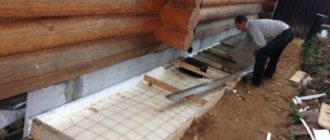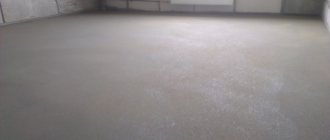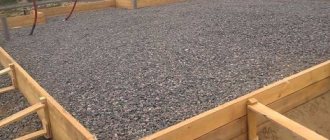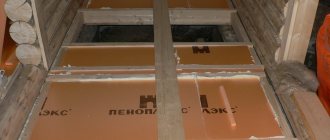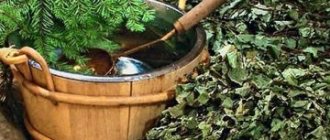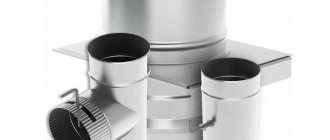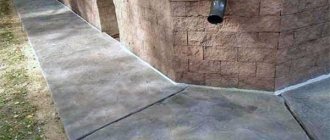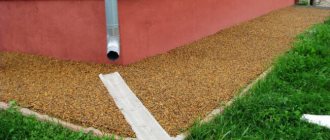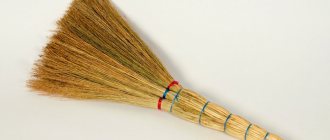To make the room reliable and durable, it is necessary to equip a solid foundation. To accomplish this task, a blind area made of concrete is used, since this material is considered one of the most reliable. Compliance with installation rules will allow you to create a high-quality structure that will be used for its intended purpose for many years.
Polypropylene fiber
Universal polypropylene reinforcing fiber for adding to the solution.
More details
The underlying layer serves to create a level base and distribute the load. It can be made of sand, crushed stone, clay. Which material to choose depends on the material of the decorative coating. For a concrete blind area, an underlying layer of crushed stone and sand is arranged with separating layers of geotextile.
The top covering is made of concrete or piece materials (tiles, paving stones).
The thickness of the underlying layers under the concrete blind area is 10–20 cm, the thickness of the concrete blind area is from 10 cm. Moreover, taking into account the slope, a meter-wide blind area will have a thickness of 10 cm at the thin edge, and 13–15 cm near the wall.
How to arrange a concrete blind area?
The production of a concrete blind area includes several stages.
Requirements for building materials
To create a blind area, it is necessary to take into account some requirements when choosing a material.
Sand
Sand can be quarry or river, as both are suitable for this design. But due to the high cost, the first option is usually used.
Crushed stone
When creating a structure, you can use crushed stone of different fractions. When laying, the material will differ:
- crushed stone up to 5 mm is used for dusting;
- Material up to 20 mm is excellent for compaction;
- large stones up to 40 mm are not suitable for the top layer;
- crushed stone from 40 mm is used only in the construction of large structures.
In addition, crushed stone can be acute-angled, flaky, cuboidal and wedge-shaped. When making a blind area, it is recommended to use crushed stone of a fraction of 5-40 mm.
Read more here.
Membrane
It is recommended to use a high quality profiled membrane. This material has 2 layers: a membrane with convexities through which water will be drained, as well as geotextiles.
Clay
The cheapest material for creating a blind area is clay. It reliably protects the foundation from precipitation. Used as the first layer of the cake for waterproofing.
Preliminary work
Before constructing the blind area, the following preliminary work is carried out:
- Make markings. Pegs are driven into the corners of the building and the height of the blind area along the base is marked. Having retreated the width of the blind area, drive in the second row of pegs and mark the height of the outer edge of the blind area (minimum 10 cm). Pull the cord.
- They remove the soil around the house to the depth of the underlying layers. It is important to remove all the roots of the plants so that they do not try to germinate later.
- The bottom of the trench is compacted.
- The formwork is installed so that its upper edges protrude beyond the ground level by at least 80–100 mm.
- Layers of sand and crushed stone are poured. Each layer must be compacted. The layers are poured immediately with the design slope. Geotextiles are laid between layers of sand and crushed stone. The minimum thickness of the underlying layers is 10 cm.
- Lay insulation from extruded polystyrene foam in a layer of 10 cm. It is better not to ignore this step, since the insulated blind area protects the foundation from cracking and allows you to reduce the cost of heating the house. Having spent once on insulation, you can save on heating for years in the future.
- Spread a film for cut-off waterproofing, for example, from a greenhouse polyethylene film in two layers. It is laid with an approach to the wall 10 cm above the upper edge of the future blind area so that moisture from the concrete mixture does not go into the sand after laying.
Video description
The video shows how a blind area with a semi-rigid covering, or more precisely from paving slabs, is constructed:
And the third type is with a soft coating. The latter is clay, which is laid in a thick layer. This option for forming a blind area was used in the construction of small dachas. The economy option is used very rarely today. But we must pay tribute to the clay blind areas, which coped well with their functions. They were usually covered with gravel or crushed stone on top, which served purely decorative functions.
New technologies for constructing a blind area
Today, with the appearance on the market of a huge number of new building materials, it has become possible to form blind areas in the form of flower beds. They do it like this:
- a trench
around the house , already with a slope; - cover its bottom and walls with a waterproofing membrane
- they cover it on top geotextiles
, his task isdon't givethe ability for
the roots
of planted plants
to tear the waterproofing
; - a sand-crushed stone mixture
is poured in , which will serve as
a drainage system
; - They fill up the fertile layer
, on which flowers and herbs are planted.
This option for constructing a blind area is an excellent solution for decorative filling of a suburban area. The only disadvantage of a hidden blind area, as builders sometimes call it, is the inability to walk on it.
Soft blind areas with green spaces Source yandex.ru
Expansion seams
The concrete blind area is a monolithic slab of quite large size. During the process of gaining strength, stresses will inevitably arise in the material, which can lead to cracking.
One way to reduce such risks is to reinforce the blind area with steel mesh or equally effective and more cost-effective volumetric fiber reinforcement, but expansion joints cannot be avoided. They are arranged across the width of the blind area every 2–2.5 m. To do this, install ordinary boards 15–20 mm thick, placed on edge.
In addition, you need to take into account that the blind area is a structure that is operated in the open air, which means that it will inevitably experience the effects of temperature changes. As we remember from the physics course, a physical body expands when heated and contracts when cooled. For such a large structure as a blind area, these differences can be quite large. This means that the concrete will put pressure on the base, which can lead to its cracking. That is why expansion joints along the perimeter of the base cannot be avoided. They are also arranged using regular boards installed on edge. At the junction of the blind area with the wall, a damper tape made of foamed polyethylene is installed. Subsequently, the boards will need to be removed and the seams covered with sand or filled with sealant.
Preparing the fill
Stages of work
Before construction, it is necessary to make a competent and detailed drawing. This document will help you calculate materials and determine the sequence of work. First comes the preparatory stage, which consists of arranging a pit for installing the blind area.
This activity is carried out in the following sequence:
- Marking on the ground. Performed using a tape measure and rope on stakes.
- Removing the top grass layer of soil. It can be used to repair damaged areas of the lawn or for landscaping.
- Digging a trench. Depending on the degree of heaving of the soil, the depth is 15-40 cm. Giving the bottom a slope. To do this, use a shovel and a level. At 1 m of the ditch bottom there should be a height difference of 2-3 cm.
- Soil compaction. You can use a hand tamper, which is a log with handles. If the work area exceeds 50 m², it is advisable to rent a mechanical vibrator.
- Laying geotextile fabric. A more practical and reliable option is roofing felt. Both materials are laid in strips with overlapping edges at the joints by 15-20 cm. The geotextile is glued with aluminum tape, and the roofing felt is held together with tar. The edges of the material need to be placed on the wall and glued to it. This will eliminate the possibility of water leaking under the stove when washing the walls or condensation forming on them.
- Insulation. Extruded polystyrene foam sheets are best suited for this. The material has low thermal conductivity, sufficient strength and elasticity to withstand soil movements. Underestimation of this stage leads to freezing of the soil and destruction of the blind area. A warm foundation will last longer without routine and major repairs.
- Arrangement of backfill. It consists of layers of fine crushed stone and coarse sand. In heaving soils, the height of the cushion can reach 30 cm. On solid soil, 15 cm is quite enough. The backfill must be carefully leveled, spilled with water and compacted well. The uniformity of load acceptance from the concrete strip will depend on this.
- Production of formwork. The best option is 20 mm boards, which at the same time prevent the solution from spreading and serve as beacons of the pouring level. The boards are installed along the walls and across the tape every 200 cm. Subsequently, these jumpers will act as a shock absorber during the thermal expansion of concrete. If you plan to leave them, the wood must first be treated with an antiseptic and any hydrophobic agent. Another technology assumes that after the solution has hardened, the boards will be removed and the openings will be filled with a polymer sealant.
- Making the frame. If you plan to use the blind area as a pedestrian path, you can take a ready-made mesh with a mesh size of 30-50 mm from a 6-8 mm rod. For transport, the base must be stronger. Here it is better to use a volumetric frame made of 10-12 mm reinforcement. The rods can be fastened together by welding, wire or plastic ties.
The final stage of the preparatory work is to check the strength of the installation of the assembled structures. All components must be reliable and stable, since concrete creates a high load on all surfaces.
Reinforcement of the blind area
Let's return briefly to such an important topic as blind area reinforcement.
It is usually recommended to do this if the blind area is built on weak, heaving soil in order to prevent cracking of the concrete slab.
For reinforcement, a steel mesh with a cell size of 10 cm and a thickness of 5 mm is used, which is laid overlapping. This is a rather labor-intensive operation; in addition, purchasing a mesh is an additional expense.
A much more profitable, less labor-intensive, inexpensive, but reliable option is volumetric reinforcement with polypropylene or basalt fiber. Fiber is simply added to a concrete mixture or mortar, it disperses easily and evenly, providing increased strength, durability, reduced abrasion, increased impact strength of concrete, and also prevents cracking.
We advise you to study: To replace fittings
Concrete laying
When all the preparatory work is completed, the concrete mixture is placed into the formwork in compliance with the design slope. For better results, use vibration treatment or use special additives for concrete, but more on that later.
Important!
Concrete hardening should occur at a temperature of 18–22°C, taking into account nighttime temperature drops. At a minimum, during the first days after laying the concrete, approximately this temperature should be provided.
Care of the blind area
It is no secret that the strength of concrete depends not only on its composition, but also on the conditions under which hardening occurs.
The laid concrete must be protected from the sun, precipitation, and drafts; A canopy made of polyethylene film is suitable for these purposes.
Hardening processes are most active in the first hours after installation. After 2–3 hours, the concrete will set and will no longer be pressed through with your fingers. At this moment, you need to cover it with a soft cloth and pour water from a watering can. This procedure must be repeated for the first 2-3 days after installation to maintain the optimal moisture content required for hydration reactions in the mixture to occur. Otherwise, the edges of the slab will dry out, and this will lead to a decrease in the strength of the blind area.
Functions and tasks
The main function of the blind area is to remove moisture from the foundation.
Private construction involves large material costs, since high-quality materials and equipment cost a lot of money. However, you should not save on arranging the blind area. Such a decision can lead to expensive major repairs to the foundation of the house within several years after its construction.
The concrete slab around the house performs the following functions:
- protection of the foundation from moisture;
- preventing erosion of the soil near the house by the flow of rainwater;
- giving the building a complete appearance;
- creating a pedestrian path for walking and moving small loads;
- additional thermal insulation layer.
The slabs can be used as a walkway in winter in buildings of low height. Please remember that falling snow or icicles from your roof can cause injury and even death.
How to make a blind area more durable: secrets of professionals
Have you ever thought about why professionals do things better than amateurs? Of course, experience matters, but you can’t do without “secret tricks.”
One of these life hacks is the use of special additives for concrete, which allow you to give special properties to concrete mixtures.
To make a blind area, it is necessary to use the CemAqua additive, which will ensure high water resistance of the solution, increase frost resistance, do not cause corrosion of the reinforcement metal, and at the same time it is an effective plasticizer of the mixtures.
We also recommend considering an additive such as Plastix from CEMMIX. This is a plasticizer used to increase the mobility of the concrete mixture and increase the strength of concrete.
Which is better to choose?
When creating a blind area, it is recommended to use the following materials:
- paving slabs,
- paving stones,
- rubber crumb.
Such coatings are expensive, but have high technical characteristics, properties and a long service life.
The design looks presentable . Thanks to the large number of shades, you can choose the one that suits the design of your country house.
You can find out how to make a blind area around a house from stone here, and from brick - here.
Polypropylene fiber
Universal polypropylene reinforcing fiber for adding to the solution.
More details
The addition of these plasticizers helps prevent delamination of the concrete mixture and also increases its mobility, so that concrete can be laid with high quality without vibration treatment.
In addition, plasticizers can reduce the water requirement of the mixture by 10–20% and reduce the amount of cement in it without loss of strength by at least 10%.
As a result, given the low consumption of plasticizer, it comes out free.
Due to the fact that CemAqua and Plastix are supplied in liquid form, packaged in 10-liter canisters, it is easy and convenient to dose and add to concrete mixtures.
After gaining strength, the concrete blind area must be treated with CemAquaStop - a complex moisture-repellent surface treatment agent. The water repellent eliminates the appearance of efflorescence, increases the durability of the surface, virtually eliminates its damage by fungi and mold, eliminates soaking and water absorption in the direct contact of moisture, without reducing the vapor permeability of the surface (the material “breathes”). As a result of using “CemAquaStop”, a very thin hydrophobic coating is formed on the surface of the material - an invisible layer of polymer, which, when exposed to moisture, closes the pores of the material and prevents water from penetrating inside. After treating the blind area with a water repellent, the frost resistance and durability of the treated material increases several times.
The use of modern materials when concreting a blind area allows us to produce a high-quality and durable product, which ultimately saves money, time and effort. The CemAqua and Plastix plasticizers, as well as the CemAquaStop water repellent, can be purchased in Leroy Merlin stores, online stores, and also wholesale from the manufacturer.
You can buy CemPlast, CemBase CEMMIX without leaving your home, with discounts from 5 to 33%!!!!
Buy on Ozon
Buy on Yandex.Market
Buy on Wildberries
Buy at Leroy Merlin
Or you can find the nearest official dealer in your region on our map
← Strong and durable blind area: how to prepare cement mortar and what additives to use
How to make a concrete floor in a private house →
Return to list
Comments
News
We are always ready to help
Cemmix has opened a free hotline
to help you with any questions related to construction using concrete additives. Call and ask, our consultants are always ready to help!
Hyperplasticizer
Hyperplasticizers are a new type of plasticizing additives for concrete, ensuring the mobility of the mixture above P5. In addition to plasticity, they increase the water resistance and frost resistance of concrete by 2-3 times.
